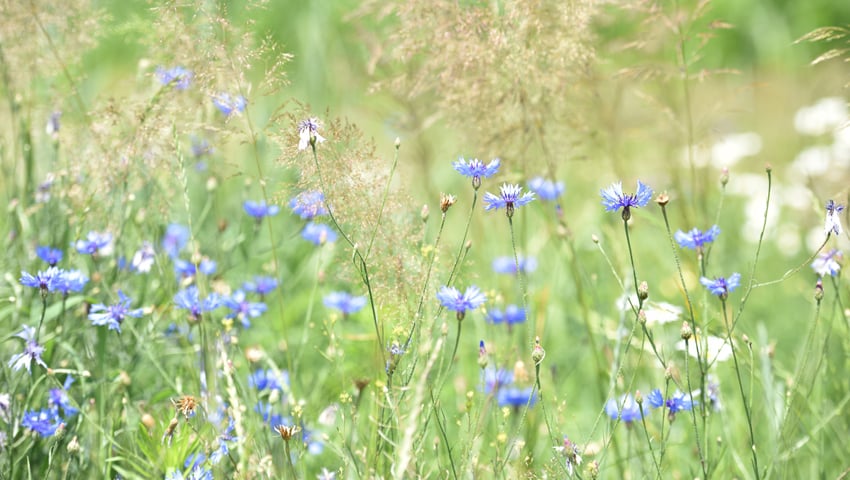Article by John Harold, Farm Partnership Officer, Plantlife
After decades of neglect and harm, England’s remaining species-rich grasslands are being further depleted.
This news comes from Defra, which is, perhaps inadvertently, funding their conversion to herbal leys – temporary grasslands made up of legume, herb and grass species.
Species-rich grasslands are the nation’s biggest resource – and government needs to take a strategic approach. That’s why Plantlife is calling for a Grassland Action Plan.
Herbal leys
A recent Defra blog describes how herbal leys (even the name has an enticing floral scent) are used to ‘balance intensive livestock farming with environmental conservation’ in the White Peak, Derbyshire. But do they live up to their billing as the ultimate herbal remedy for farming?
Applied with care, herbal leys can undoubtedly generate environmental and farming benefits in arable rotations or where they replace intensive swards of ryegrass-white clover or ryegrass monoculture. But is that what is happening on the ground?
Herbal leys are seen as a success story for the Environmental Land Management scheme (ELMs), in terms of how many farmers have taken up the option. By July 2024, 292,000ha of farmland was enrolled in the SAM3 Herbal Leys option of the Sustainable Farming Incentive (SFI). At £382/ha per year, those hectares provide a welcome income to farmers, though establishment and maintenance take bites out of the headline figure.
Failure to measure outcomes
Measured by their environmental benefits, however, rather than area enrolled, the picture is more complex.
How many hectares in SAM3 are improving soil health, water infiltration or soil carbon? No-one knows, because the emphasis in SFI is on uptake rather than outcomes.
Monitoring requirements are minimal, and the environmental purpose of the SFI action is defined only loosely. As a temporary sward, the cycle of cultivation means that carbon sequestered will be released back to the atmosphere. Even the plant diversity, which is meant to be their superpower, is only weakly defined; Defra stipulates the use of a ‘seed mix which includes all of the following (as a minimum): 1 grass species, 2 legume species, 2 herb or wildflower species’. There is no requirement for native species or control of seed provenance.
If the outcomes for nature and climate were universally positive, perhaps it wouldn’t matter if the cost-benefit calculation for SAM3 herbal leys was a little woolly. But we now know that the outcomes of the SFI Herbal Ley action in some cases are far from positive.
Despite Defra eligibility rules for SAM3 stipulating ‘arable land, including temporary grassland, as well as improved permanent grassland’, anecdotal evidence has been gathering that high nature value or restorable habitats – in particular species-rich grassland – are being entered into the SFI herbal ley option.
You can see how some farmers may have arrived at such a decision. The payment rates for SAM3 herbal leys are attractive, they are seen as carrying little paperwork, and there is lots of positive publicity for them as a win-win for farming and nature. However, herbal leys should not replace more diverse, permanent pasture.
Public funds destroying permanent pasture
The anecdotes have now been replaced by hard evidence. Defra is allowing some of the most biodiverse permanent pasture and meadows to be converted to temporary leys.
In The Times (online, 19th January 2025 Bee-friendly grasslands dug up thanks to ‘perverse’ subsidies) a Defra spokesperson is quoted saying that, ‘by area, just 1.5 per cent of priority habitat species-rich grassland, such as hay meadows, had been turned over to herbal leys.’
We know enough to be astonished at this loss of irreplaceable grassland habitat, perplexed that Defra allowed this, and concerned to see whether they stop it from happening again. The most precious of England’s grasslands, damaged by a scheme that should have them at the core of its purposes. Is that a good use of public money?
We’ll have to wait to find out exactly how much species-rich grassland has been destroyed as an unintended consequence of agri-environment funding. Until Defra release the actual data, a back-of-envelope calculation puts the figure in the hundreds or thousands of hectares – a significant proportion of our priority grassland habitats.
For example, the latest estimate for upland hay meadows is that only 870 hectares remain. Without action from Defra, even more species-rich grassland will be lost.
Sometimes it is the details that help us understand the big picture. The unfolding story of herbal leys is a case in point.
In 2024, the National Audit Office found that the herbal ley option was taking up a quarter of the entire SFI budget, and that SFI was taking budget share from more ambitious ELM programmes that deliver more effective nature and climate actions. Perhaps the key finding was that some ELM objectives are not linked to monitoring that would tell Defra whether they were working or not.
How often is the answer to complex issues to be found in the pick-and-mix approach that SFI embodies? Impressive uptake figures tell us little about progress on nature, climate and the sustainability of farming. Farmers – and nature – need an approach from government that is long term and strategic.
For species-rich grasslands, the issues are systemic. Policy on farming, environment and nature needs to be more joined up. ELM needs stronger links between its purposes, structure, monitoring and implementation.
As the nation’s biggest resource, it’s time for strategic thinking and action on grasslands. Time, perhaps, for a Grassland Action Plan?
John Harold is the Farm Partnership Officer, Plantlife
Plantlife’s Grassland Action Plan web pages can be found here
